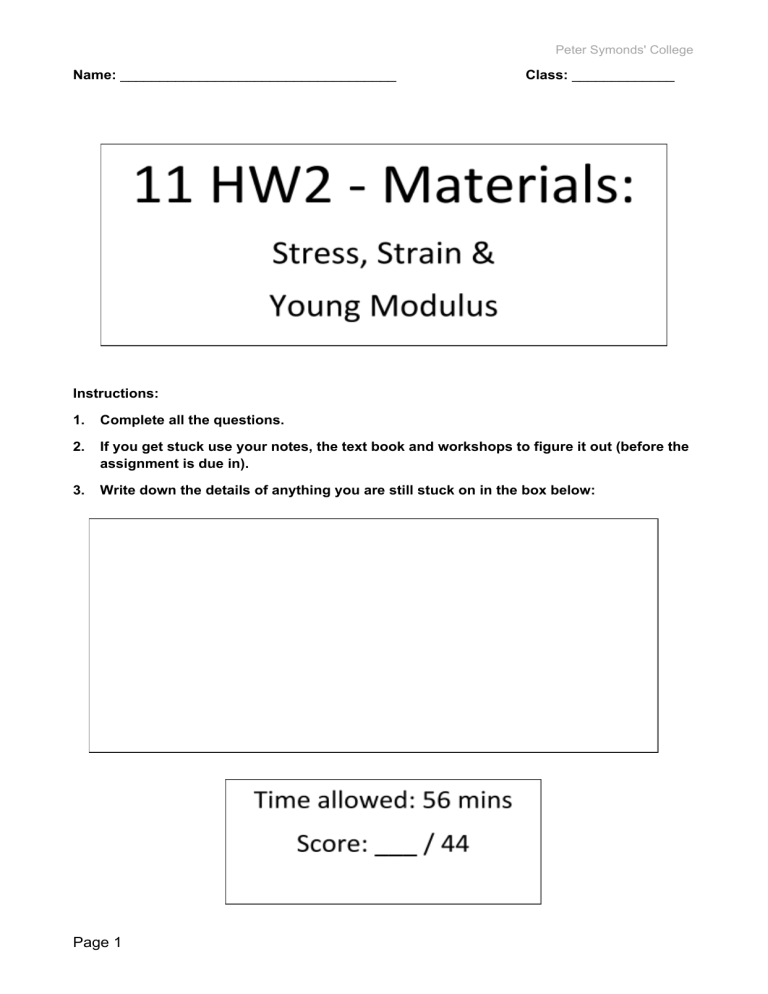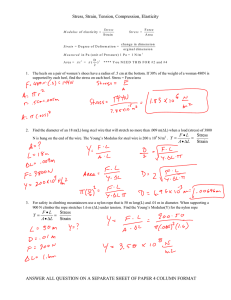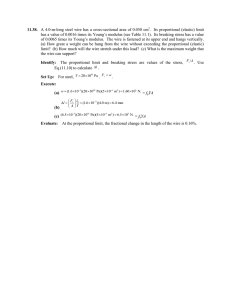
Peter Symonds' College Name: ___________________________________ Class: _____________ Instructions: 1. Complete all the questions. 2. If you get stuck use your notes, the text book and workshops to figure it out (before the assignment is due in). 3. Write down the details of anything you are still stuck on in the box below: Page 1 Peter Symonds' College Q1. Two vertical copper wires X and Y of equal length are joined as shown. Y has a greater diameter than X. A weight W is hung from the lower end of Y. Which of the following is correct? A The strain in X is the same as that in Y. B The stress in Y is greater than that in X. C The tension in Y is the same as that in X. D The elastic energy stored in X is less than that stored in Y. (Total 1 mark) Q2. The diagram shows how the stress varies with strain for metal specimens X and Y which are different. Both specimens were stretched until they broke. Which of the following is incorrect? A X is stiffer than Y B X has a higher value of the Young modulus C X is more brittle than Y D Y has a lower maximum tensile stress than X (Total 1 mark) Page 2 Peter Symonds' College Q3. The graph shows the variation of stress with strain for a ductile alloy when a specimen is slowly stretched to a maximum strain of εm and the stress is then slowly reduced to zero. The shaded area A represents the work done per unit volume when stretching the specimen B represents the energy per unit volume recovered when the stress is removed C represents the energy per unit volume which cannot be recovered D has units of J m–1 (Total 1 mark) (a) State Hooke’s law for a material in the form of a wire and state the conditions under which this law applies. Q4. ...................................................................................................................... ...................................................................................................................... (2) (b) Page 3 A length of steel wire and a length of brass wire are joined together. This combination is suspended from a fixed support and a force of 80 N is applied at the bottom end, as shown in the figure below. Peter Symonds' College Each wire has a cross-sectional area of 2.4 × 10–6 m2. length of the steel wire = 0.80 m length of the brass wire = 1.40 m the Young modulus for steel = 2.0 × 1011 Pa the Young modulus for brass = 1.0 × 1011 Pa (i) Calculate the total extension produced when the force of 80 N is applied. ............................................................................................................. ............................................................................................................. ............................................................................................................. ............................................................................................................. (ii) Show that the mass of the combination wire = 4.4 × 10–2 kg. density of steel = 7.9 × 103 kg m–3 density of brass = 8.5 × 103 kg m–3 ............................................................................................................. ............................................................................................................. ............................................................................................................. ............................................................................................................. ............................................................................................................. (7) (c) A single brass wire has the same mass and the same cross-sectional area as the combination wire described in part (b). Calculate its length. ...................................................................................................................... ...................................................................................................................... ...................................................................................................................... ...................................................................................................................... (2) (Total 11 marks) Q5.(a) The Young modulus is defined as the ratio of tensile stress to tensile strain. Explain what is meant by each of the terms in italics. tensile stress ................................................................................................. ........................................................................................................................ ........................................................................................................................ Page 4 Peter Symonds' College tensile strain ................................................................................................... ........................................................................................................................ (3) (b) A long wire is suspended vertically and a load of 10 N is attached to its lower end. The extension of the wire is measured accurately. In order to obtain a value for the Young modulus of the material of the wire, two more quantities must be measured. State what these are and in each case indicate how an accurate measurement might be made. quantity 1 ........................................................................................................ method of measurement ............................................................................... ........................................................................................................................ quantity 2 ........................................................................................................ method of measurement ................................................................................ ........................................................................................................................ (4) (c) Sketch below a graph showing how stress and strain are related for a ductile substance and label important features. (2) (Total 9 marks) Page 5 Peter Symonds' College Q6. The table below shows the results of an experiment where a force was applied to a sample of metal. (a) On the axes below, plot a graph of stress against strain using the data in the table. Strain / 10–3 0 1.00 2.00 3.00 4.00 5.00 6.00 7.00 8.00 9.00 10.00 Stress /108 Pa 0 0.90 2.15 3.15 3.35 3.20 3.30 3.50 3.60 3.60 3.50 (3) (b) Use your graph to find the Young modulus of the metal. answer = ...................................... Pa (2) Page 6 Peter Symonds' College (c) A 3.0 m length of steel rod is going to be used in the construction of a bridge. The tension in the rod will be 10 kN and the rod must extend by no more than 1.0mm. Calculate the minimum cross-sectional area required for the rod. Young modulus of steel = 1.90 × 1011 Pa answer = ...................................... m2 (3) (Total 8 marks) Q7. The diagram below shows a tower crane that has two identical steel cables. The length of each steel cable is 35 m from the jib to the hook. (a) Each cable has a mass of 4.8 kg per metre. Calculate the weight of a 35 m length of one cable. weight = ................................. N (2) Page 7 Peter Symonds' College (b) The cables would break if the crane attempted to lift a load of 1.5 × 106 N or more. Calculate the breaking stress of one cable. cross-sectional area of each cable = 6.2 × 10−4 m2 breaking stress = ................................ Pa (2) (c) When the crane supports a load each cable experiences a stress of 400 MPa. Each cable obeys Hooke’s law. Ignore the weight of the cables. Young modulus of steel = 2.1 × 1011 Pa (i) Calculate the weight of the load. weight = ................................. N (2) (ii) The unstretched length of each cable is 35 m. Calculate the extension of each cable when supporting the load. extension = ................................. m (3) (iii) Calculate the combined stiffness constant, k, for the two cables. stiffness constant = ........................... Nm−1 (2) Page 8 Peter Symonds' College (iv) Calculate the total energy stored in both stretched cables. energy stored = ................................... J (2) (Total 13 marks) Page 9



